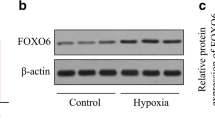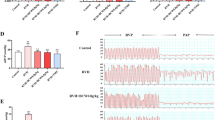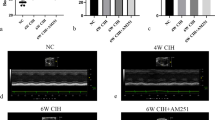Abstract
High-altitude exposure has been linked to cardiac dysfunction. Silent information regulator factor 2-related enzyme 1 (sirtuin 1, SIRT1), a nicotinamide adenine dinucleotide-dependent deacetylase, plays a crucial role in regulating numerous cardiovascular diseases. However, the relationship between SIRT1 and cardiac dysfunction induced by hypobaric hypoxia (HH) remains unexplored. This study aims to assess the impact of SIRT1 on HH-induced cardiac dysfunction and delve into the underlying mechanisms, both in vivo and in vitro. In this study, we have demonstrated that exposure to HH results in cardiomyocyte injury, along with the downregulation of SIRT1 and mitochondrial dysfunction. Upregulating SIRT1 significantly inhibits mitochondrial fission, improves mitochondrial function, reduces cardiomyocyte injury, and consequently enhances cardiac function in HH-exposed rats. Additionally, HH exposure triggers aberrant expression of mitochondrial fission-regulated proteins, with a decrease in PPARγ coactivator 1 alpha (PGC-1α) and mitochondrial fission factor (MFF) and an increase in mitochondrial fission 1 (FIS1) and dynamin-related protein 1 (DRP1), all of which are mitigated by SIRT1 upregulation. Furthermore, inhibiting PGC-1α diminishes the positive effects of SIRT1 regulation on the expression of DRP1, MFF, and FIS1, as well as mitochondrial fission. These findings demonstrate that SIRT1 alleviates HHinduced cardiac dysfunction by preventing mitochondrial fission through the PGC-1α-DRP1/FIS1/MFF pathway.








Similar content being viewed by others
Data availability
No datasets were generated or analysed during the current study.
References
Wright AD (2006) Medicine at high altitude. Clin Med (Lond) 6:604–608
Murray AJ, Montgomery HE, Feelisch M, Grocott M, Martin DS (2018) Metabolic adjustment to high-altitude hypoxia: from genetic signals to physiological implications. Biochem Soc Trans 46:599–607
Wang Y, Xu P, Wang Y, Liu H, Zhou Y, Cao X (2013) The protection of salidroside of the heart against acute exhaustive injury and molecular mechanism in rat. Oxid Med Cell Longev 2013:507832
Lo MY, Daniels JD, Levine BD, Burtscher M (2013) Sleeping altitude and sudden cardiac death. Am Heart J 166:71–75
Vonk Noordegraaf A, Westerhof BE, Westerhof N (2017) The Relationship between the right ventricle and its load in Pulmonary Hypertension. J Am Coll Cardiol 69:236–243
Shah AK, Bhullar SK, Elimban V, Dhalla NS (2021) Oxidative stress as a mechanism for functional alterations in Cardiac Hypertrophy and Heart failure. Antioxid (Basel) 10:931
Lorell BH, Apstein CS, Weinberg EO, Cunningham MJ (1990) Diastolic function in left ventricular hypertrophy: clinical and experimental relationships. Eur Heart J 11(Suppl G):54–64
Nehra S, Bhardwaj V, Kar S, Saraswat D (2016) Chronic hypobaric hypoxia induces right ventricular hypertrophy and apoptosis in rats: therapeutic potential of Nanocurcumin in improving adaptation. High Alt Med Biol 17:342–352
Jurcut R, Haugaa K, La Gerche A (2018) The right ventricle: from bench to Bedside. Biomed Res Int 2018:2868437
Pena E, Brito J, El Alam S, Siques P (2020) Oxidative stress, kinase activity and inflammatory implications in right ventricular hypertrophy and heart failure under hypobaric hypoxia. Int J Mol Sci. ;21
Rode B, Bailey MA, Marthan R, Beech DJ, Guibert C (2018) ORAI Channels as potential therapeutic targets in Pulmonary Hypertension. Physiol (Bethesda) 33:261–268
Cong L, Lei MY, Liu ZQ et al (2021) Resveratrol attenuates manganese-induced oxidative stress and neuroinflammation through SIRT1 signaling in mice. Food Chem Toxicol 153:112283
Zhao Y, Zhang J, Zheng Y et al (2021) NAD(+) improves cognitive function and reduces neuroinflammation by ameliorating mitochondrial damage and decreasing ROS production in chronic cerebral hypoperfusion models through Sirt1/PGC-1α pathway. J Neuroinflammation 18:207
Aguilar M, González-Candia A, Rodríguez J et al (2018) Mechanisms of Cardiovascular Protection Associated with Intermittent Hypobaric Hypoxia exposure in a rat model: role of oxidative stress. Int J Mol Sci. ;19
Karbasforooshan H, Karimi G (2017) The role of SIRT1 in diabetic cardiomyopathy. Biomed Pharmacother 90:386–392
Prola A, Pires Da Silva J, Guilbert A et al (2017) SIRT1 protects the heart from ER stress-induced cell death through eIF2α deacetylation. Cell Death Differ 24:343–356
Luo G, Jian Z, Zhu Y et al (2019) Sirt1 promotes autophagy and inhibits apoptosis to protect cardiomyocytes from hypoxic stress. Int J Mol Med 43:2033–2043
Huang Q, Su H, Qi B et al (2021) A SIRT1 activator, Ginsenoside Rc, promotes Energy metabolism in Cardiomyocytes and neurons. J Am Chem Soc 143:1416–1427
Hu L, Ding M, Tang D et al (2019) Targeting mitochondrial dynamics by regulating Mfn2 for therapeutic intervention in diabetic cardiomyopathy. Theranostics 9:3687–3706
Dong Q, Wu Z, Li X et al (2014) Resveratrol ameliorates cardiac dysfunction induced by pressure overload in rats via structural protection and modulation of ca(2+) cycling proteins. J Transl Med 12:323
Ding M, Ning J, Feng N et al (2018) Dynamin-related protein 1-mediated mitochondrial fission contributes to post-traumatic cardiac dysfunction in rats and the protective effect of melatonin. J Pineal Res. ;64
Xu X, Zhang Q, Hu JY et al (2013) Phosphorylation of DYNLT1 at serine 82 regulates microtubule stability and mitochondrial permeabilization in hypoxia. Mol Cells 36:322–332
Rodgers JT, Lerin C, Haas W, Gygi SP, Spiegelman BM, Puigserver P (2005) Nutrient control of glucose homeostasis through a complex of PGC-1alpha and SIRT1. Nature 434:113–118
Abate M, Festa A, Falco M et al (2020) Mitochondria as playmakers of apoptosis, autophagy and senescence. Semin Cell Dev Biol 98:139–153
van der Bliek AM, Shen Q, Kawajiri S (2013) Mechanisms of mitochondrial fission and fusion. Cold Spring Harb Perspect Biol. ;5
Xia P, Liu Y, Cheng Z (2016) Signaling pathways in Cardiac Myocyte apoptosis. Biomed Res Int 2016:9583268
Ooi JY, Bernardo BC, McMullen JR (2014) The therapeutic potential of miRNAs regulated in settings of physiological cardiac hypertrophy. Future Med Chem 6:205–222
Dorn GW 2nd (2007) The fuzzy logic of physiological cardiac hypertrophy. Hypertension 49:962–970
Cohn JN, Ferrari R, Sharpe N (2000) Cardiac remodeling–concepts and clinical implications: a consensus paper from an international forum on cardiac remodeling. Behalf of an International Forum on Cardiac Remodeling. J Am Coll Cardiol 35:569–582
Manabe I, Shindo T, Nagai R (2002) Gene expression in fibroblasts and fibrosis: involvement in cardiac hypertrophy. Circ Res 91:1103–1113
González-Candia A, Candia AA, Paz A et al (2022) Cardioprotective antioxidant and anti-inflammatory mechanisms Induced by Intermittent Hypobaric Hypoxia. Antioxid (Basel). ;11
Parra V, Bravo-Sagua R, Norambuena-Soto I et al (2017) Inhibition of mitochondrial fission prevents hypoxia-induced metabolic shift and cellular proliferation of pulmonary arterial smooth muscle cells. Biochim Biophys Acta Mol Basis Dis 1863:2891–2903
Joo HY, Yun M, Jeong J et al (2015) SIRT1 deacetylates and stabilizes hypoxia-inducible factor-1α (HIF-1α) via direct interactions during hypoxia. Biochem Biophys Res Commun 462:294–300
Jiang W, Zhang P, Yang P et al (2022) Phosphoproteome Analysis identifies a synaptotagmin-1-Associated Complex involved in ischemic Neuron Injury. Mol Cell Proteom 21:100222
Song M, Franco A, Fleischer JA, Zhang L, Dorn GW 2 (2017) nd. Abrogating mitochondrial dynamics in Mouse hearts accelerates mitochondrial senescence. Cell Metab. ;26:872 – 83.e5.
Twig G, Elorza A, Molina AJ et al (2008) Fission and selective fusion govern mitochondrial segregation and elimination by autophagy. EMBO J 27:433–446
Burman JL, Pickles S, Wang C et al (2017) Mitochondrial fission facilitates the selective mitophagy of protein aggregates. J Cell Biol 216:3231–3247
Kleele T, Rey T, Winter J et al (2021) Distinct fission signatures predict mitochondrial degradation or biogenesis. Nature 593:435–439
Losón OC, Song Z, Chen H, Chan DC (2013) Fis1, Mff, MiD49, and MiD51 mediate Drp1 recruitment in mitochondrial fission. Mol Biol Cell 24:659–667
Ding Q, Qi Y, Tsang SY (2021) Mitochondrial Biogenesis, Mitochondrial Dynamics, and Mitophagy in the maturation of Cardiomyocytes. Cells. ;10
Zou D, Chen K, Liu P, Chang H, Zhu J, Mi M (2014) Dihydromyricetin improves physical performance under simulated high altitude. Med Sci Sports Exerc 46:2077–2084
Friedman JR, Nunnari J (2014) Mitochondrial form and function. Nature 505:335–343
Zhang XY, Zhang XJ, Xv J et al (2018) Crocin attenuates acute hypobaric hypoxia-induced cognitive deficits of rats. Eur J Pharmacol 818:300–305
Funding
This work was partially supported by a grant from the foundation [grant number 2019CXTD01]. The funding bodies played no role in the design of the study, the collection, analysis, or interpretation of data or in writing the manuscript.
Author information
Authors and Affiliations
Contributions
Conception and design: W.L Liu, Z.L Chen and L.L Pu; Acquisition of data: H.B Xu, X.N Song, X.R Zhang, G.R Wang, X.L Cheng, L Zhang; Analysis and interpretation of data including statistical analysis, biostatistics, and computational analysis: W.L Liu, H.B Xu, X.N Song, X.R Zhang, Z.RR Wang, R Li, C.Y Ai, X.X Wang; Writing, review, and/or revision of the manuscript: W.L Liu, H.B Xu, X.N Song and X.R Zhang; Administrative, technical, or material support including reporting or organizing data: W.L Liu, H.B Xu, X.N Song, X.R Zhang, Z.L Chen and L.L Pu; Study supervision: W.L Liu, Z.L Chen and L.L Pu.
Corresponding authors
Ethics declarations
Ethical approval
All animal experiments were performed in accordance with the NIH guidelines and were approved by the Institutional Animal Care and Use Committee of Environmental and Operational Medicine Research Department.
Conflict of interest
The authors declared that they have no conflicts of interest to this work.
Additional information
Publisher’s Note
Springer Nature remains neutral with regard to jurisdictional claims in published maps and institutional affiliations.
Electronic supplementary material
Below is the link to the electronic supplementary material.
Rights and permissions
Springer Nature or its licensor (e.g. a society or other partner) holds exclusive rights to this article under a publishing agreement with the author(s) or other rightsholder(s); author self-archiving of the accepted manuscript version of this article is solely governed by the terms of such publishing agreement and applicable law.
About this article
Cite this article
Xu, H., Song, X., Zhang, X. et al. SIRT1 regulates mitochondrial fission to alleviate high altitude hypoxia inducedcardiac dysfunction in rats via the PGC-1α-DRP1/FIS1/MFF pathway. Apoptosis (2024). https://doi.org/10.1007/s10495-024-01954-5
Accepted:
Published:
DOI: https://doi.org/10.1007/s10495-024-01954-5




